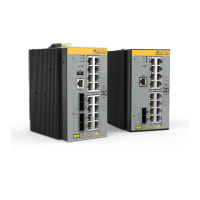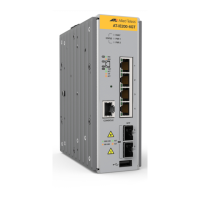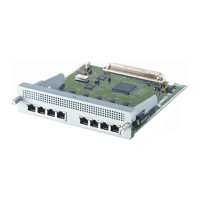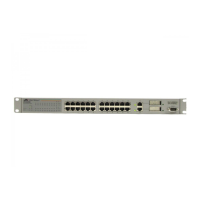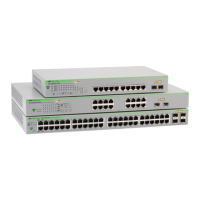C613-50631-01 Rev A Command Reference for IE340 Series 3390
AlliedWare Plus™ Operating System - Version 5.5.3-0.x
TRIGGER COMMANDS
TYPE
ENV-SENSOR
type env-sensor
Overview Use this command to create a trigger that will run a script when the device’s
environment sensors detect an event. Environment sensors are shown in the
output of the command show system environment, and include things like device
temperature, power settings and voltage.
Depending on the device and sensor, you can create a trigger to run when:
• the sensor’s state changes, for example when a loss of power is detected for
a power supply, or when power is restored, or both.
• the sensor’s reading crosses a high or low threshold, for example when the
device temperature becomes too high, or returns to normal, or both.
Syntax when a
sensor changes
state
type env-sensor resource <resource-id> sensor <sensor-id> state
{true|false|any}
Syntax when a
sensor crosses a
threshold
type env-sensor resource <resource-id> sensor <sensor-id>
{low-limit|high-limit} {exceeded|cleared|any}
Parameter Description
resource
<resource-id>
The ‘Resource ID’ for the device, as shown in output of the
command show system environment.
sensor
<sensor-id>
The ‘ID’ for the sensor, as shown in output of the command show
system environment.
state true The trigger will activate if this sensor reading changes to ‘Yes’ or
‘Open’ in the output of show system environment.
state false The trigger will activate if this sensor reading changes to ‘No’ or
‘Closed’ in the output of show system environment.
state any The trigger will activate if this sensor reading changes to any of
‘Yes’, ‘Open’, ‘No’, or ‘Closed’.
Parameter Description
resource
<resource-id>
The ‘Resource ID’ for the device, as shown in output of the
command show system environment.
sensor
<sensor-id>
The ‘ID’ for the sensor, as shown in output of the command show
system environment.
low-limit The trigger will activate when the sensor reading falls below the
‘Low Limit’ alarm threshold shown in show system environment,
or returns to an acceptable value after being too low, or both. The
alarm threshold values are pre-defined within the device and
cannot be changed.

